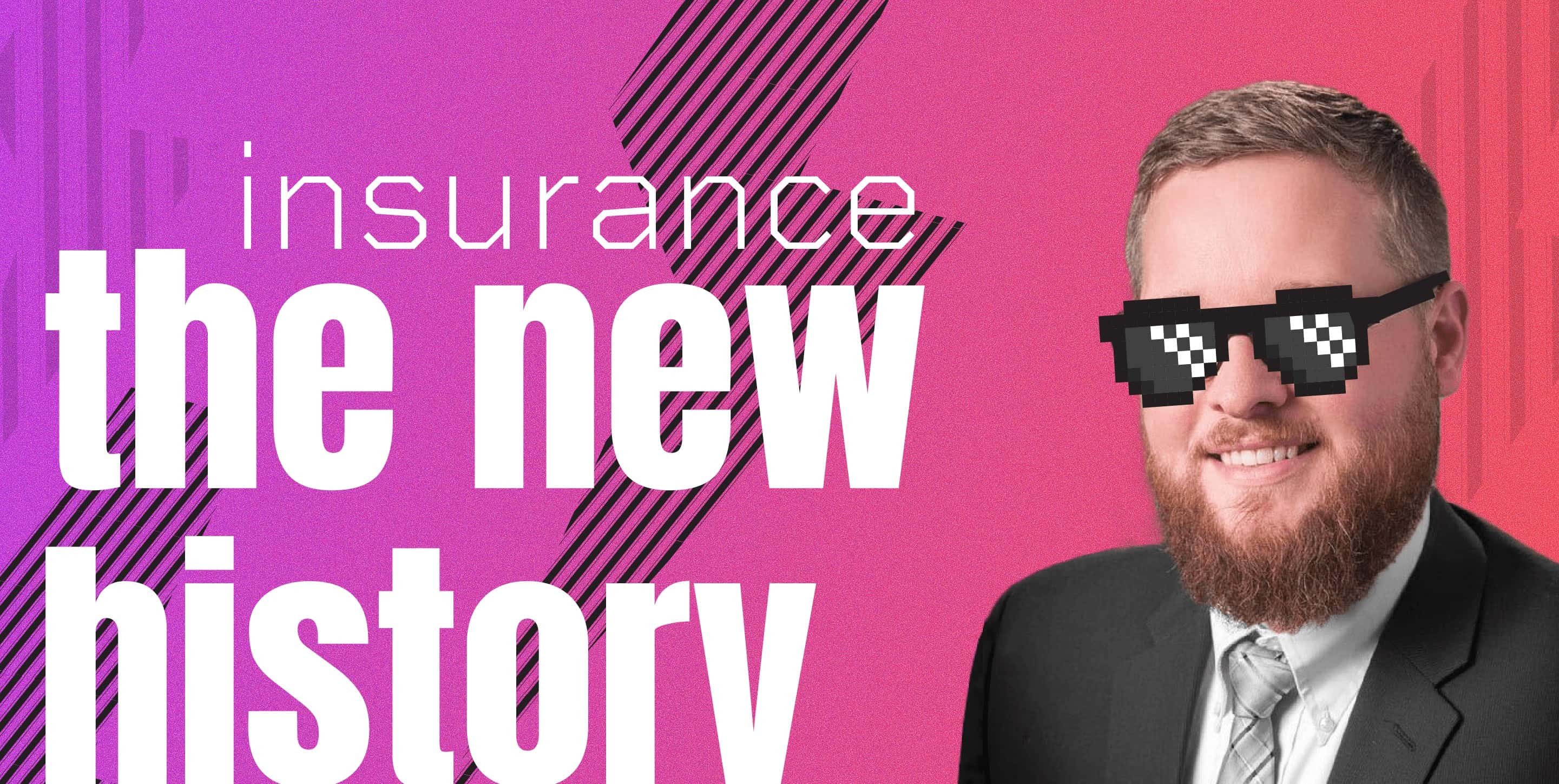Insurance: The New History
History, as we all know, is written by the victor. Winning means you get to tell your side of the story and have it live on through time as the facts as they accurately happened. How the simple passage of time elevates one person’s perspective to the absolute truth I’ll never know, but that’s how it is. In order to be history, you have to make history.
I’m going to venture into the world of insurance and tackle history with a more agile approach. In this new blog series, “Insurance: The New History” we’ll take a dive into the things happening in insurance and around insurance now, or things that I think will be a major player in the industry very soon. This is my perspective on the what, the why, and the how of history-making tech in insurance.
These articles should serve as an innovation jumpstarter or, better yet, get companies to think “let’s try something different” instead of “this is the way we’ve always done it; this is the way we’ll keep doing it.”
I’m hoping this helps people in insurance be the victor, the historian of record for their own stories.
Be the disruptors, not the disrupted.
Did anyone use Palm, Blackberry, Zune, or even IBM SPC?
How many people remember the first Smartphone ever? Sure, you’re thinking, I remember my first iPhone? Actually, you need to go back farther.
The first smartphone was created by IBM in 1992 and released in 1994. It was called the Simon Personal Communicator. Offered at $1,100 (surprisingly close to the latest iPhone prices), this phone was the prototype of what a smartphone would become. Fast forward through internet-connected phones, Blackberry, and even the failed Motorola/Apple experiment. There were quite a few smartphones before June 2007, but then iPhone came along and completely changed how the world thinks about what a phone should be, and the rest is – not even very well-known – history.
You might be asking yourself, why is this guy giving me a history lesson about mobile phones?
That’s a great question and if you take nothing else away from this blog, it should be that companies with a ton of money, but an inability to execute and a lack of innovative ideas, will be downgraded to a footnote in the history books, often not even warranting their own chapter.
There isn’t one successful insurtech company
According to Investopedia, insurtech refers to the use of technology innovations designed to squeeze out savings and efficiency from the current insurance industry model. It basically is the usage of technology within the insurance industry to disrupt. There are many types of insurtechs in the market. Some focus on providing a simple tech solution to carriers, others are insurance startups that utilize tech to form a true digital insurance company which could be a carrier, broker, agent, or MGA.
For the most part, insurtechs haven’t been successful. (Yes, I just said that, and yes, I mean it). There have been zero companies that have disrupted the insurance world. That isn’t to say there haven’t been what could be considered wins in this space.
One can point to Root Insurance and say they are the first insurtech unicorn, valued at $3.5 billion over a year ago, and say that they are a successful insurtech. Other’s that are now in that unicorn category include Clover, Hippo, PolicyBazaar, and of course Lemonade, which has since gone public.
But what makes an insurance company successful? Success in this industry goes way beyond the classic startup high-dollar valuation rite of passage.
Many insurtechs are by all accounts successful startups, but I can’t say they are successful insurance companies. When I look at an insurance company to see if they are a success, I look at Direct Written Premium, Combined Ratio, and if I can find it, Customer Retention.
You have to ask the question, do they run a good insurance business? Maybe not yet. Goliaths of the industry are often quick to dismiss insurtechs entirely or view them as ripe grounds for cherry-picking innovative ideas to drive their own business forward.
Still… it’s worth remembering that the original Goliath got taken down by a small fry with good aim and a little bitty pebble.
Transparency should change your research
For years, insurance companies have tried to hide how the proverbial sausage is made. Through my experience, insurance carriers want to help customers understand more about their policies and pricing but have made little effort to expose the other aspects of their companies. Other than through regulated filings, there’s little to no transparency regarding how an insurance company really works, the mechanisms and assessments behind pricing and payouts, or company numbers.
A couple of companies started showing others how to be totally transparent – Uber with its engineering blog and shockingly, Lemonade Insurance.
A lot of carriers will blow off Lemonade Insurance as a startup that can’t compete with the industry’s titans, or refer to some of their old financial data that shows a high loss ratio, claims issues, premium issues, insurance customer fraud, etc. Every insurance company deals with this, but because Lemonade doesn’t have a long history of doing well, people in the industry will write off looking into what they might be doing right.
I wasn’t one of these. I knew that Lemonade was onto something different when I heard the CEO of the company talk at an insurtech conference about hiring a Chief Behavioral Officer.
In insurance, if you have high losses, you’ll typically have a fair amount of fraudulent claims. What a carrier will typically do is buy a system that can help them manage fraudulent claims, some AI that can determine if a claim might be fraudulent, and spend a lot of money on manpower to physically track down the fraud.
I would imagine Lemonade relies on some of those old school fraud techniques as well, but they went about trying to prevent fraud in an entirely new way. Their innovation in this area has had me following their company for years.
When life insurance gives you lemons
Lemonade looked at human behavior to see if they could understand the triggers that led to people trying their hand at some really shady claims. They were focusing on the prevention of fraudulent losses instead of responding to fraud. They hired their Chief Behavioral Officer, Dan Ariely, who has a great background in looking at why humans do what they do, especially around dishonesty. He has a ton of research out there that is great to dive into but one thing he talks about that really struck me was this – we lie to ourselves and justify it.
This definitely happens in insurance. People think, “It’s me against the behemoth insurance company. My claim won’t hurt a company that makes billions.” Because of this, and I believe in an attempt to stop fraud at the gates, Lemonade put a great process in place.
When you file a claim with Lemonade, they remind you of how their model works and that extra money goes to charities that you determine. They have a small statement that has you “understand” what fraud does to things you care about. Next, they have you record a statement of what happened. This is a video statement that forces you to look at yourself while explaining. There are behavioral reasons for why this is a step in the process instead of just submitting pictures and typing in text boxes. It then goes through dozens of AI anti-fraud algorithms. If your claim is instantly approved, they pay within seconds, otherwise, it goes to humans who help you immediately. You can read more about how the process works, and why, here.
There are a few key takeaways here on the genius of their approach. There is nothing in their process that doesn’t feel natural in terms of how you process a first notice of loss (FNOL). Also, AI can be simplistic at first and improved very quickly when more data is available on how that AI is working. And most importantly, this is a simplified way – for the customer and the company – to get the claim to a person only when a person is needed. Due to the easy claims process and the ability to weed out bad claims very early, Lemonade should have great customer retention.
Lemonade also has a whole blog series on #transparency! They talk about their successes, their failures, and the why of both. A great example is how they have focused on continually improving their loss ratio through AI. They released the AI tools (AI Jim is the claims bot named after the head of Claims Jim Hageman) and focused on data analysis to improve the claims.
Ultimately, they look at solving problems differently, and their new approach to age-old problems hits paydirt. AI Jim along with AI Maya and some tools that Lemonade built internally, Forensic Graph Network and Project Watchtower, worked to take Loss Ratio from a horrific 166% in Q4 2017 to 73% in Q4 of 2019. I think the industry average for Loss Ratio is somewhere around 88%. How they did this is written all over their blog.
Research – innovation’s secret sauce

Insurtechs might not be the best insurance companies, and when we look back at their history some of those unicorns might still be thriving, but there’ll also be some dodos. But insurtechs do excel at something many of those old, storied insurance organizations struggle with – change.
Insurtechs don’t look at IT as a separate part of the business, it’s just a part of what they do. Companies like Lemonade have literally laid out how they’ve tackled major – longstanding – problems in the insurance industry. Research how insurtechs – or tech companies in general – have solved problems and try to apply new approaches to your business model.
Previously, as Chief Architect at a Fortune 500 carrier, it was my duty to understand what was going on around the world, not just in the insurance industry, but everywhere. My research was broad and weird and constant. I was always trying to make connections that could set our company apart.
My research wasn’t about trying to come up with a solution or a program no one had ever thought of before, it was about learning and understanding the smartest ways people were solving the kind of problems my company – and insurance in general – were trying to fix.
In tech, transparency is the new black and there are blogs aplenty with miles of good stuff worth your time. When you find good blogs, take notes. Insurance blogs are great, but you shouldn’t limit yourself to just this industry. There’s gold in other hills as well:
“All of this is great,” you’re probably thinking, “but you’re talking about tech companies, not insurance and that certainly can’t apply to me. I don’t have resources, tools, or people to make all of this work.”
You may be right, but all those things can change (really). You are not going to get radical results by following the Insurance IT playbook to the letter. If a company is saying they have a problem that you’re struggling with, understand how they solved it technically, but also what they did differently in terms of culture, processes, and people.
What does that look like?
It looks like this –
Implement tools and processes that enable the enterprise to solve business problems with tech. Look at your hiring practices. Hire the best people possible – and those may not be the people who have the most programming languages under their belt. Get people that have solved really big problems in unique ways. Hire employees that care about working with others, doing things differently, and using tech as a way of solving problems.
Purchase tools to help abstract the complexity out of the tech so the entire enterprise can use new tools to solve old problems. Let your Actuarial team loose on the AI portions. They are chomping at the bit to get ahold of solving real problems with AI. They have the mathematical background and most have taught themselves python with AI libraries.
To innovate in the modern world, you don’t have to have all the money, tools, tech, people, and everything else readily available. It just might take a different approach to research and then creatively applying that research to your own organization.
Steve Jobs is one of the greatest copycats, be like Steve
The iPhone wasn’t really the first smartphone, but it was the first best smartphone. It was lightyears beyond everything that came before it that redefined the category. Steve Jobs and Apple didn’t rewrite history by thinking, “let’s just make this one thing a little bit better.” They broke a billion-dollar industry by making all the aspects of the existing technology the best they could possibly be. That’s legit innovation.
When insurance companies are looking to solve problems – they often copy and paste the latest, greatest, singular innovation in the industry and give themselves a very satisfied pat on the back. That’s not enough. You need to look at all the successes, the big wins, and the newest unicorns and find the best solutions for everyone in the insurance value chain.
When you figure out how to make customers, agents, partners, carriers, and regulators feel happy and satisfied, your company will maintain growth for another century.
This is not impossible; it just hasn’t happened yet.
Take a page from the book of [Steve] Jobs – look at the world around you and improve on the business you can control.


